On the digital battlefield, the rodent in your hand could make all the difference between victory and defeat. You’ll want to pick the right one to follow you from the forests of Endor to the fantastic landscapes of Pandora, because the truth is, not all mice are created equal.


On the digital battlefield, the rodent in your hand could make all the difference between victory and defeat. You’ll want to pick the right one to follow you from the forests of Endor to the fantastic landscapes of Pandora, because the truth is, not all mice are created equal.

CORSAIR M65 PRO RGB
Compared to some of the other mice reviewed here, the Corsair M65 Pro RGB is decidedly utilitarian. This means no fancy features like removable grips or OLED displays. Instead, it’s clearly aimed at gamers who want a no-nonsense mouse that just works. It features the excellent PixArt PMW 3360 optical sensor, which is currently regarded as the best sensor on the market right now. As expected, tracking performance was flawless on various surfaces, and the sensor is going to be one of the strongest draws for mouse aficionados. But even though we said the mouse is utilitarian, that doesn’t mean that it’s sparse on features. The M65 Pro RGB comes with a weight tuning system, an increasingly rare feature these days. It has three screws at the bottom which enclose compartments with three separate weights, so you can opt to remove the internal weights, or both weights and screws, in order to make the mouse lighter. This is an ergonomic right-handed mouse, and there’s a clear groove at the side for your thumb. That’s also where the sniper button is located, and you can press it to lower your DPI for more precise shots. The forward and back buttons are placed above it – easy enough to reach, but they can be a bit narrow. The matte plastic coating on the sides has a slightly rough, grainy feel to it, which resists the buildup of dirt and grime fairly well. On top of that, the mouse actually boasts an aluminum base, which is something you don’t see every day. This means a lovely brushed metal finish on the bottom, in addition to a wonderfully solid construction. Another nice touch is the color-coded DPI indicator. You can toggle through up to five DPI steps using the buttons below the scroll wheel, and you can tell what settings you’re at by the color of the LED indicator. This is one of the more comfortable mice we’ve reviewed so far, and the overall experience was very pleasant, with good tracking, springy left- and right-click buttons, and an elegant design.

AT A GLANCE
SENSOR: 12,000DPI PixArt
PMW: 3360 optical
NUMBER OF BUTTONS: 8 programmable buttons
WEIGHT: 135.5g 115g (w/o weights)
DIMENSIONS: 118 x 72 x 39mm PRICE $129


LOGITECH G900 CHAOS SPECTRUM
The Logitech G900 Chaos Spectrum is a mouse hell bent on dispelling all the negative notions associated with wireless mice. Too heavy? The G900 is uncannily light. Laggy performance? Logitech’s latest flagship performs faithfully even in wireless mode. Perhaps battery life is bad then? Nope, Logitech is claiming up to 30 hours of continuous use. The biggest promise of the G900 is its ability to deliver wireless gaming performance on par with regular cabled solutions. And in this respect, it delivers admirably. While most gamers are instinctively wary of all things wireless and the inherent latencies they introduce, the G900’s performance in wireless mode is indistinguishable from when it is hooked up to the cable. The optical sensor itself works flawlessly, with no noticeable acceleration or jitter. Even in fast-paced shooters like Counter-Strike: Global Off ensive and Overwatch, the mouse tracked precisely without a hitch. Having wireless devices in the vicinity didn’t seem to aff ect it either, even though they were all connected to a 2.4GHz network, the same frequency spectrum that the G900 transmits in. Then there are the modular side buttons, which can be added or removed to suit both right- and left-handers, or even blocked out with a dummy button to prevent you from accidentally pressing them. Battery life is similarly excellent, and the mouse is able to last through around four to five days of heavy usage without charging. The mouse accommodates a variety of grips, including palm, fingertip, and claw grips. The rather generic, oblong shape doesn’t favor one grip over another, although fingertip gamers may prefer a slightly shorter, more compact mouse. Finally, it’s exceedingly light for a wireless mouse at a mere 107g, thanks to small details like the thin wall molding and a hollow scroll wheel that resembles bicycle spokes. The matte plastic material also proved wonderfully adept at resisting dirt and grime over long hours of gaming, so you won’t have to keep wiping the mouse down.
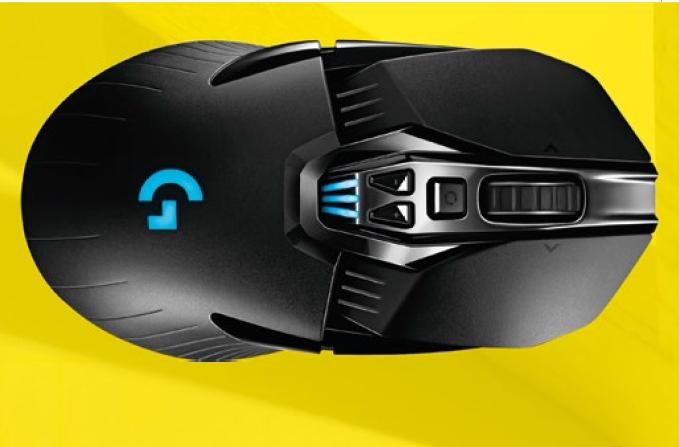
AT A GLANCE
SENSOR: 12,000DPI PixArt
PMW: 3366 optical
NUMBER OF BUTTONS: 11 programmable buttons
WEIGHT: 107g
DIMENSIONS: 130 x 67 x 40mm
PRICE: $249


MAD CATZ R.A.T. PRO X
If the Transformers were mice, they’d be the Mad Catz R.A.T. Pro X. While most mice come with a fixed shape and size that you’ll either love or hate, the R.A.T. Pro X has a mind-boggling array of customization options that enable you to subtly tweak the mouse’s shape and even its glide. When holding it, it feels more like multiple pieces of hardware put together and not a single product, so those who prefer their mice simple will likely be put off. However, others will be thrilled by what they can do with it. For starters, the palm rest can be moved up and down or tilted from left to right. Alternatively, you can swap it out for a lower profile piece or a perforated one that offers better breathability. The mouse feels primarily like a claw grip one to us, but you can still palm it with some adjustments. The side grips are kept in place by screws, which you can unscrew using the included Allen wrench and replace with a piece with a less prominent finger rest. Another nice touch is the inclusion of a second pair of Teflon mouse feet, which provides a more controlled glide than the pre-installed ceramic mouse feet. But the customization options don’t end there, and you can also adjust the resistance of the scroll wheel with the Allen wrench, and swap out the metal wheel for a rubber one. One particularly novel feature is the side-to-side movement of the scroll wheel, which tilts on an analog axis and lets you strafe left or right by varying degrees. Finally, the sensor itself is modular, much like the one on the SteelSeries Rival 700. It snaps in place with magnets, so it’s a lot easier to remove than the Rival 700’s sensor, and you can opt for an optical sensor as well. In our time with it, the mouse didn’t give us any problems with tracking, and our only gripe is the bright neon color, which probably isn’t everyone’s cup of tea. It’s also a pity that with so many customization options, it’s still a righthanded only mouse.

AT A GLANCE
SENSOR: 8,200DPI PixArt
ADNS: 9800 laser
NUMBER OF BUTTONS: 7 programmable buttons
WEIGHT: 105g
DIMENSIONS: Customizable
PRICE: $329

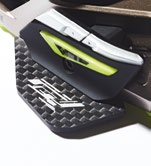
RAZER MAMBA
Razer’s flagship mouse is the only other hybrid mouse in our shootout, capable of operating in both wired and wireless modes. While we praised the Logitech G900 for its wireless performance, the Mamba is no slouch either. In fact, we’d say that wireless performance and overall signal integrity was on par with the G900. Logitech would probably disagree with us when it comes to parsing the milliseconds, but any differences between the two are negligible in day-today use. The 16,000DPI Philips Twin Eye sensor has gotten a bad reputation because of previous flawed iterations – for instance the z-axis tracking issue where the cursor would move when the mouse was lifted – but the current version largely fixes those issues. When it comes to grip style, the Mamba will satisfy the vast majority of gamers. The mouse has a high arch in the middle, and is quite comfortable for claw, palm, and fingertip grips. The side buttons are also positioned right above where your thumb would naturally rest, so there’s no need to stretch to reach them at all. The entire mouse feels really wellbuilt, and the matte plastic top cover, in addition to the rubber grips at the sides, further improve the overall handling of the mouse. Then there’s the fact that this is also one good-looking mouse. LED illuminated rails on the side pulse to life when the mouse is powered on, and you can customize them with various effects or sync them with other Chroma-enabled Razer devices. Having said that, the most novel feature on the mouse is probably the ability to adjust the resistance on the left- and right-click buttons. This is done by cranking the mechanism left or right with the included hex bit tool, and is easy enough to do. There are actually 14 different levels of resistance – ranging from 45g to 95g – that you can set, but the difference between the lightest and heaviest click is still rather subtle.

AT A GLANCE
SENSOR: 16,000DPI Philips Twin Eye PLN-2034 laser
NUMBER OF BUTTONS: 9 programmable buttons
WEIGHT: 125g
DIMENSIONS: 128 x 70 x 42.5mm
PRICE: $239


STEELSERIES RIVAL 700
Every now and then, someone sets out to redefine what a particular genre of product is expected to do. This time, that someone is SteelSeries and its flagship Rival 700 mouse, which comes with ostentatious features like an OLED display and – wait for it – tactile alerts. The tactile alerts function to notify gamers of certain in-game events, like when the round ends in Counter- Strike: Global Offensive. Alternatively, it can also alert you when the cooldown timer on a certain ability is up, or when your health is critical. The idea is for you to gain a better awareness of what’s going on in the game, which is probably why the software that controls it has been dubbed Gamesense. Having said that, we’re not sure that the feature is actually necessary. The motor vibrates along a vertical plane, so it doesn’t shift your mouse from left to right and affect tracking, but it could still be a bit distracting if you aren’t used to having your mouse vibrate (which is most of us). The OLED display is another feature that’s controlled by the Gamesense software. You can download GIFs or display your own custom drawn image or text, but the display can also be used to display in-game statistics like your kills. Unfortunately, the number of games that support Gamesense is still quite limited for now, with only Counter-Strike: Global Offensive, Dota 2, and Minecraft. Again, that’s another reason why we’re questioning the overall utility of these features. Until there’s support for more games, it’s going to be little more than a novelty. That aside, the mouse comes with two detachable cables of different lengths to suit various setups. The PMW 3360 optical sensor – just an alternate name for the PMW 3366 in the Logitech G900 – didn’t show any issues with tracking, and we were able to hit our shots without feeling like the mouse was letting us down. Ultimately, the Rival 700 has a lot going for it, but it ends up being bogged down quite literally by the weight of its features. This is a rather large mouse, and at 135g, is also a rather hefty one. This means it’s more difficult to pick it up or make quick flicks with your wrist.

AT A GLANCE
SENSOR: 16,000DPI PixArt PMW 3360 optical
NUMBER OF BUTTONS: 7 programmable buttons
WEIGHT: 135g
DIMENSIONS: 125 x 68 x 42mm
PRICE: $169
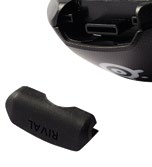

TT ESPORTS LEVEL 10 M ADVANCED
The new Tt eSports Level 10 M Advanced is an upgraded version of 2012’s Level 10 M gaming mouse. It retains the characteristic design of its predecessor, but comes updated with features like a higher resolution 16,000DPI sensor and three-zone RGB illumination. One of the more interesting features is the adjustable height of the mouse. The mouse ships with a key that you can plug into a depression on the back of the mouse and crank the height up or down. This allows the mouse to accommodate gamers who like flatter mice and those who prefer a higher arch as well. Having said that, we still found the mouse a little awkward to hold, and couldn’t quite get used to the base plates that extend from the bottom. The side button placement felt less than optimal as well. The traditional forward and back buttons are circular instead of wedge-shaped, and are a bit hard to reach for users with smaller hands. We liked the five-axis button and the on-screen display that pops up when you switch the DPI, but it can protrude rather uncomfortably against the base of your thumb when gripping the mouse. The left- and right-click buttons also require quite a bit of force to actuate, and even then they still felt strangely mushy. There also wasn’t much spring to them, which means it wasn’t as comfortable executing actions like a series of rapid taps. What’s more, they can only be activated if you press in the middle, which might be a problem for claw grip gamers who rest their fingertips on the lower half of the buttons. This is a rather heavy mouse, even more so than the Rival 700, so FPS players who constantly execute quick swipes may not like it as much. That said, we didn’t notice any big problems with tracking (although the Avago 9800 has been known to have acceleration issues), so if you can get past the uncomfortable shape, the budget gamer will be happy with its performance and the versatile five-axis button.
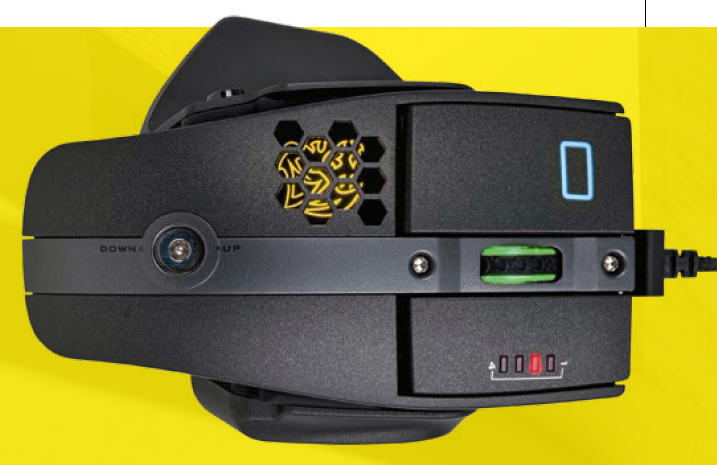
AT A GLANCE
SENSOR: 16,000DPI Avago 9800 laser
NUMBER OF BUTTONS: 10 programmable buttons
WEIGHT: 161.9g
DIMENSIONS: 131 x 87 x 41mm
PRICE: $99



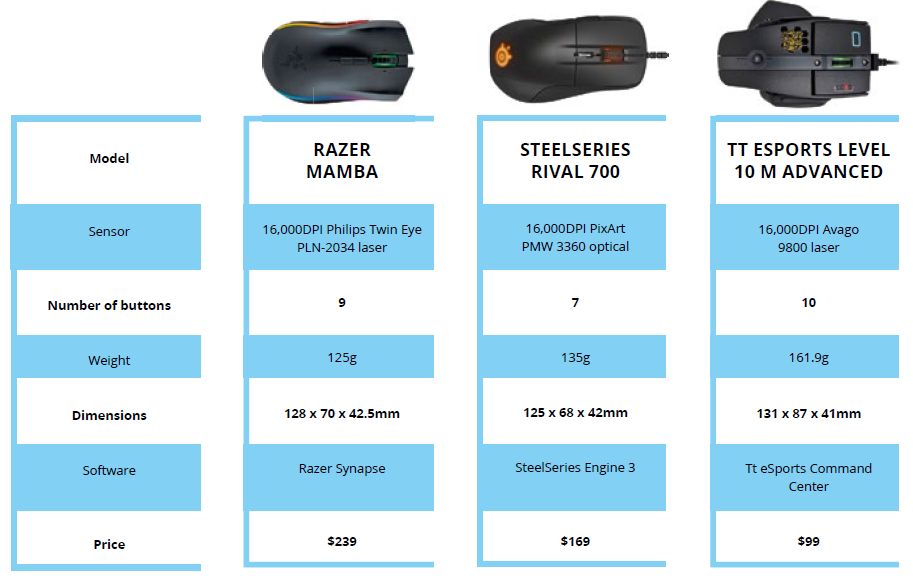
And the best flagship gaming mouse is

LOGITECH G900 CHAOS SPECTRUM
While all these mice sit at the top, or at least near the top, of their respective product lines, there’s no quite beating the Logitech G900’s compelling mix of features, performance, and design innovation. The G900 combines a market-leading sensor with impeccable wireless performance and strong battery life, and the result is probably the best wireless gaming mouse available today. It handily defies the traditional drawbacks of wireless mice, with an impressively light design and latency that rivals its wired counterparts. And when you take into account its ambidextrous design, modular side buttons, and comfortable shape, it becomes pretty clear that this is a mouse that will please just about anyone.

CORSAIR M65 PRO RGB
Corsair’s mouse nets the award for best value because of its judicious selection of features and class-leading sensor. It is not the most feature-packed mouse in our shootout, but what it off ers should be more than enough for even the most demanding gamer. Things like an OLED display and tactile alerts are great, but they don’t have much utility at this point (because of limited support from games), and gamers are likely to get more out of things like a well-designed weight-tuning system and solid build quality. Couple all that with a sensor that performs flawlessly – and without any extraneous buttons to get in the way – and you have a mouse that will serve you well and doesn’t break the bank.























